RCA Researcher of the Month
The RCA Researcher of the Month was a series that ran from 2018 to 2021 that recognized and honored individuals who expressed creativity, curiosity, and an honest and deliberate quest for excellence in their research activities.
April 2021: Josh Marineau, PhD
Like many other researchers, Josh Marineau admits to always having a healthy curiosity about everything and recalls how it led him to dismantle objects around the house as a youth (much to the chagrin of his parents) just to see how they worked. As an associate professor of management at NDSU, Josh still enjoys the paths his curiosity leads him and he researches topics including organizational behavior, social networks and the entrepreneurship culture in Fargo, North Dakota. Originally from Idaho, Josh moved to Alaska when he was young. Other than considering a degree in philosophy, he never really considered the world of academia as a career choice. Instead, art and theater were his primary disciplines. After beginning his business career he wasn’t even sure he’d go to college. | 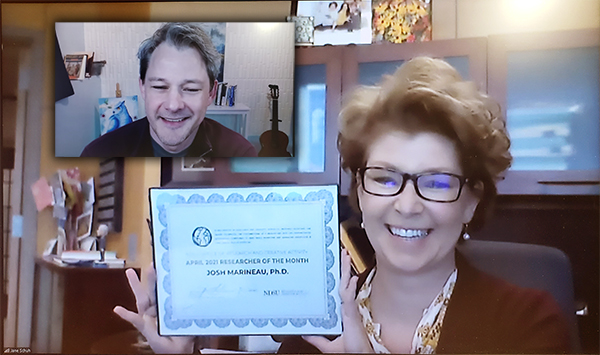 |
“I was still in high school when I started working at a coffee shop at 16,” he recalls. “Before long I was managing 11 locations with over 100 employees.” Even with his natural skills and success at business, Josh decided to enroll at the University of Alaska – Anchorage and obtain a degree in philosophy. However, that program wasn’t available at the time so instead he earned a bachelor’s degree in English rhetoric (along with a minor in philosophy). After graduating, the Dean suggested that he go to graduate school to become a professor and take a teaching position at the university. Josh considered the suggestion and while he hadn’t planned on graduate school, he figured that an MBA could help him become a better business leader. He applied for grad school and was accepted at the University of Kentucky. While his mentors at Alaska had prepared him for what it would take to earn a higher degree, the University of Kentucky program would open him up to new concepts and a research career path.
Josh joined the University of Kentucky College of Business at the same time that they introduced a brand-new program based on social networks with a new group of world-class professors. His fellow students and he found themselves to be the first cohort in the new program with a new curriculum that was both challenging and robust. However, it opened up interests in Josh that he still follows today. “It was a rigorous research-oriented program that stressed theory, data collection, and the scientific method that was new to me, but was also really appealing,” he said.
The methods that Josh learned at the University of Kentucky showed him that as a researcher, he could be the creator of knowledge, a concept that linked him back to his love of art. Josh sees connections in how he approaches his research to his painting, woodwork, and musical endeavors. He finds his happy place to be when he’s exploring the structure of a problem. “While there is always an amount of structure in art, beyond a certain point pure creativity takes over,” he said. “Art has no limits and exploring research data is just finding building blocks to bigger creative ideas. I enjoy research design, data collection, and analysis but I what I really love is exploring the data. There aren’t many boundaries to this exploration which is similar to how I feel when I’m painting.”
Josh’s research into organizational behavior is based on understanding how people think about the world and perceive their social networks. He likens these social structures to maps that all of us utilize to help lay out how we perceive our groups.
Josh finds the impact of these relationships interesting, especially when they are not positive. His research targets how negative relationships such as distrust impact these networks. He points out how distrust and negative relational ties among people have a huge impact on organizations.
“It’s even more thought-provoking when you consider the amount of awareness of the distrust,” he adds. “If someone is fully aware of who distrusts them, it can actually be beneficial to the organization compared to if they are unaware of it. Much the same, a leader must be situationally aware of personal conflict within their teams to ensure they are placing the correct people in the correct roles.”
In addition to this work, Josh began a new research project in 2016 in collaboration with NDSU assistant professor of management Onnolee Nordstrom investigating entrepreneurship in the Fargo-Moorhead area. Combining his expertise in social network analysis with his entrepreneurship background, the pair collected qualitative and quantitative data from local entrepreneurs and startup community members.
“While working at the new College of Business building in 2014 I noticed there was a great deal of buzz going on about entrepreneurship in the area and as we were located about two blocks from the epicenter of this in downtown Fargo, I wanted to make sure that NDSU was a part of the mix,” he recalls. Josh received funding from the Marion Kauffman Foundation and began studying how startups perceive the entrepreneurship culture. “We discovered that regardless of the type of business we studied, there was a common understanding of what it took to be a successful entrepreneur.”
When not studying social networks and entrepreneurship, Josh is also interested in understanding our capacity for faith within an organization and its effect on keeping groups together under a single priority. “Theologian Paul Tillich introduced the concept of faith as ultimate concerns,” he explains. “Ultimate concern is a priority that transcends everything else, and faith may be that one thing that helps a business to perform best and succeed.”
Josh sees his love to explore people and ideas as a true strength. He says that art is the ultimate exploration and that an artist’s goal is to create something meaningful regardless of where you end up. “My art and my data are never finished. I like to tinker and keep working with both because there are undiscovered models and ideas within each.”
With a healthy balance of the heart of an artist and the mind of a scholar, Josh Marineau is driving our understanding of what it takes to work effectively together, and for that, we recognize him as our April 2021 Researcher of the Month.
March 2021: Benjamin Laabs, PhD
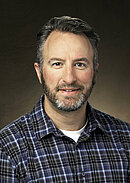
Ever since he was young, Ben Laabs has been fascinated about topics that many people find are too big to get their heads around. He spent hours thinking about why the earth works the way it does and how old were the geographic features of his native Wisconsin. As a youth, the NDSU associate professor of geosciences spent countless hours immersed in nature on the shoreline of Lake Michigan or at the various state and national parks he would visit. Ben enjoyed this time and found that he was developing a healthy curiosity about the world. However, he didn’t realize at the time that geology could be a career choice for him. That didn’t happen until years later when he took his first geology classes while studying physical therapy at the University of Wisconsin. He soon changed his major to geology after discovering a department full of both student and faculty mentors who represented a good match for what he always enjoyed about science and, most importantly, were having fun learning and researching.
The early impact of learning in a fun environment had a profound effect on Ben and he has worked to create a similar setting for his students at NDSU. He enjoys helping them see their own unique sense of place in the natural world and within the science community. Ben believes strongly that taking his students out into the field and helping them see firsthand how the earth works is a great learning motivator. His students come from many disciplines and include both undergrad and graduate students.
After earning his doctorate at the University of Wisconsin-Madison, Ben worked as an assistant professor at Gustavus Adolphus College in Minnesota and then at the State University of New York College (SUNY) at Geneseo, New York. Even though SUNY did not have a graduate program, Ben fondly remembers his nine years working with undergrads there. “I was able to help students who were coming from many urban areas see the natural world in new ways,” he recalls. “I really enjoy seeing students at the undergrad stage have their own personal ‘aha’ moments.”
Ben notes that working with undergrads is always interesting as they approach their studies from a variety of developmental levels. Given that geosciences is the basis for a wide variety of careers, working with students, getting to know their unique skills, and helping them find their own career paths is an aspect of Ben’s work that he really enjoys. “Some go on to be oceanographers while others become geospatial scientists, seismologists, or work as geologists in the mining or petroleum industry. Many opportunities are there regardless of what type of interests and curiosity a student has,” he adds.
Ben’s own research is dedicated to a simple but profound question that goes all the way back to his early days in Wisconsin. He is trying to figure out how the surface of the earth has changed since around 20,000 years ago when the last ice age occurred. Ben notes that answering parts of this question is easy, other parts are much harder to come by. While carbon dating works well to determine the age of organic materials, that process is useless for most glacial deposits. Instead, Ben looks at how the glaciers of the ice age moved materials from one spot to another.
“When a glacier covers a land mass, it moves and deposits a great deal of material,” he explains. “I study the material on the glacier’s leading edge or moraine by looking at the erratics or large boulders that were pushed and deposited by the ice as it moved across a land mass.”
Glaciers moved these erratics great distances, sometimes more than 100 miles. If they contain quartz, their age can be determined by measuring the isotopes created by the cosmic radiation they’ve absorbed. By using this relatively new procedure (developed in the late 1980s), Ben can determine how long an erratic has been in a location which then dates the time the glacier was finished moving it. By combining his data with other data sets, Ben and his team can come up with answers about how long it took for a glacier to expand and move which provides important details about the status of the earth during the ice age.
Ben’s own “aha” moments have come when he thinks he already knows an answer. But, he adds, you rarely get it right. Instead, you have to do your own due diligence to find answers.
An example of this happened when he searched out erratics in the Rocky Mountains in Utah. They were located on an existing high-end housing development so Ben had to work with the individual owners to get permission to collect samples. “In this case, we discovered that the landforms were quite a bit older than we initially assumed they would be – in fact, they were nearly 100,000 years old instead of 20,000. It turns out they were erratics from a previous ice age and that discovery changed everything.”
Ben’s work since 2003 has resulted in over 1,000 data samples and he has been able to combine his work with others collected across the nation. Seeing some of the same structures in the data has led to a collaboration with researchers at the University of California, Berkeley. Together they are developing an online calculator that will help other researchers.
In giving advice about finding good collaborators, Ben harkens back to an old adage. “I ask myself if I could spend two days paddling a canoe with someone. If the answer is yes, I’ll be able to collaborate in research with them.”
While still driven by that early question about how the earth works, Ben indicates that his inspiration has become more nuanced throughout his career. As a student, he found he was driven by the individual achievement of writing papers and passing exams. Now he finds collaboration is far more important to his own success and he notes the mentors he’s had throughout his career as important influencers to him.
He sums it up succinctly, “The value of community is that they’re always there to bring you back if you get off track.”
For living a life full of natural curiosity and helping his students develop in their own unique ways, we recognize Ben Laabs as our March Researcher of the Month.
February 2021: Dharmakeerthi Nawarathna, PhD
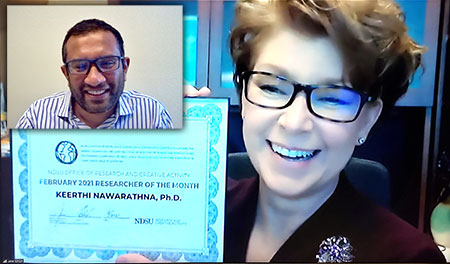
When he was young, Dharmakeerthi (Keerthi) Nawarathna developed a fascination about how circuits and electromagnets worked. His interest in these fundamental engineering concepts led him to an appreciation of engineers and all of the ideas they have contributed to society. The NDSU associate professor of electrical and computer engineering still finds himself on that same path of discovery today.
"As a child, I was passionate about everything engineering has to offer and how engineers have truly changed the world," Keerthi recalls. "Not everyone in Sri Lanka has the chance to go to college. That is why my parents always encouraged me to work hard at school -- so I could grab one of the few opportunities to attend university education to become an engineer. Once there I set myself to learning all the fundamentals of the discipline in order to succeed."
Keerthi was successful in earning a spot at the University of Peradeniya, where he studied mechanical engineering. The educational foundation he had created served him well at this time as he took advantage of all opportunities to continue learning. "I spent a lot of time in the library during my undergraduate years -- I read all the books. The more I read, the more I got excited about how I could contribute to the world." This mindset has stayed with Keerthi. He finds himself immersed in some sort of educational pursuit most of his time now, whether it's teaching or researching. "I like to think about new ideas all the time."
After graduation, Keerthi decided that merely getting a job wasn't going to give him the fulfillment he desired. While he wanted to create new ideas and take his turn at moving engineering forward in diagnostics and applicable applications, he also reflected on how he enjoyed helping others during his undergraduate studies. "I always respected my professors and it occurred to me that perhaps I could join them and become an effective educator." So he decided to continue his education and earned his doctorate in engineering physics/ applied physics at the University of Houston.
Keerthi notes that the freedom his advisor gave him in the lab at University of Houston was key to his development as a researcher. He was allowed to try, test, and validate new ideas. He also wrote often at this stage as a graduate student and was able to publish a large amount of research papers.
After spending a year as a postdoc at the University of California Irvine, Keerthi joined NDSU in 2014. Finding himself on a tenure track at a new job in a new city was stressful, but Keerthi enjoyed it. "As soon as I was hired, I began planning my lab. I determined what I would need for space, basic equipment, and software so I was ready."
Keerthi also needed to attract students to his program because he believed they would be a key piece to his work. He firmly believes that a lab and programs cannot succeed without good students. "At first I was lucky to attract two really good students. That was the start."
Given his belief that every person is a necessary part to the success his lab, Keerthi nurtures and grows relationships among his group. He spends time every day with each of his students and allows them the same level of freedom to innovate, succeed, and fail that he received in his earlier years. When Keerthi refers to his successes, it's always in terms of the partnerships he has with his students. "Students are as critical to my success as I am to theirs. My NSF CAREER award (February 2020) is really a recognition of our work together." Keerthi's role modeling methods have been effective. He's proud that both first two students he had in 2014 have now followed his path and become faculty researchers after graduating from NDSU.
This continuum of knowledge formation between the classroom and lab has helped Keerthi determine three key areas for his research.
While everything he works on still has a connection to his initial goal of improving the world, Keerthi's work in cancer screening carries a more personal tie. A close friend of his lost his wife to cancer. She had no symptoms and by the time it was detected, it was too late to save her. "I thought that there should be a way we can better detect specific kinds of cancer earlier because that could save lives. So I told myself, I'm going to make this happen."
Keerthi's work on pancreatic cancer sensors has resulted in many breakthroughs including collaboration with a group of medical experts in New Jersey who have been working on the problem for three decades. "As engineers, we can make fantastic devices and sensors that do wonderful things, but the medical professionals are the people who will be using them finally. Therefore, the time we spend in each other's lab will be highly beneficial to our overall product."
Much like the benefits of earlier cancer screening, Keerthi wondered why society couldn't better tackle the issue of obesity. To best conduct this research, Keerthi once again found the need to partner with others with different expertise. He found such partners in NDSU health, nutrition, and exercise sciences researchers Kyle Hackney and Sherri Stastny. The group is researching the problem together and providing students in both programs valuable collaboration skills and cross training.
Keerthi's third area of research is immunotherapy for cancer. While an effective treatment, it is also currently cost-prohibitive, running upwards of half a million dollars per patient. Going back to fundamentals, Keerthi points out that good engineering is about redesigning things and reducing costs. His work with Roger Maris Cancer Center is targeted at how to deliver the same value at a cost of thousands of dollars instead.
Keerthi has been on his path of discovery his whole life and he has accomplished much. He points out that the biggest difficulties of being on a tenure track is finding great students and securing funding. But he's quick to note that both happen with time and a little perseverance.
"You really need to learn how to sell your research along with finding the right people to collaborate with. When you do, good things will happen and you'll be successful."
For being a lifelong learner who wants to make the world better and someone who knows that success doesn’t occur without great partnerships, we recognize Keerthi Nawarathna as the RCA February Researcher of the Month.
January 2021: Heather Fuller, PhD
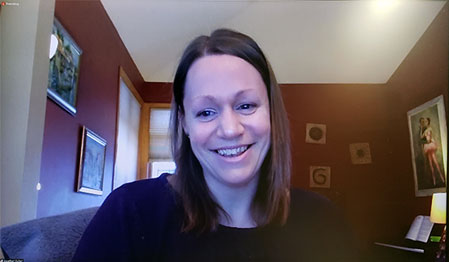 Heather Fuller's passion for working with older adults began when she was young. Through both volunteer time and jobs, she found herself drawn to them and curious about what helps them age well. As an associate professor in the department of human development and family science at NDSU, Heather has continued along this path by conducting research about the importance of social relationships throughout our lifespans including the impact of interruptions in these relationships caused by distance or, most recently, the COVID-19 pandemic.
Heather Fuller's passion for working with older adults began when she was young. Through both volunteer time and jobs, she found herself drawn to them and curious about what helps them age well. As an associate professor in the department of human development and family science at NDSU, Heather has continued along this path by conducting research about the importance of social relationships throughout our lifespans including the impact of interruptions in these relationships caused by distance or, most recently, the COVID-19 pandemic.
"Human development is a process of growth and change across the entire lifespan, from infancy to old age," says Heather. "My research focuses on the role of social support in that developmental process throughout adulthood – but especially in the later years of life. Social support from family, friends, neighbors, and communities is an integral factor influencing well-being and development. Individuals do not develop alone; our lives are linked, and through those links we influence each other’s developmental paths and outcomes."
As an undergraduate student studying psychology and Spanish at the University of Minnesota, Heather had the opportunity to start upon her path of research when she created an honors thesis studying mental health and the social connections in nursing homes in Ecuador.
"It appeared that the individuals who were more socially supported and connected were happier, healthier, and even lived longer than those who were isolated, regardless of their disease or disability level," she commented. Adding to the sense of isolation was the fact that nursing homes in Ecuador aren't a common cultural practice and many who lived in the homes felt like they had been abandoned by their families. This led to even higher rates of isolation. "Social and family connections truly seemed to affect health and wellness," she added.
After completing her undergraduate work, Heather earned a PhD in developmental psychology at the University of Michigan. To pursue her interest in the interaction of social relationships and aging, Heather worked in the Institute for Social Research at the university and began researching how social networks impact our health. As the world’s largest academic social science survey and research organization, the Institute provided Heather with opportunities to advance her training and work with large amounts of data for her studies. But for her dissertation, she was driven to work more closely with the people behind the data sets so she applied for and received a Fulbright scholarship and traveled to conduct research in Mexico.
In Mexico, Heather found an opportunity to continue her work about how families cope with separation given the unique situation of families being physically split by a border and she studied how these kinds of cultural forces and policies affected older adults' family and interpersonal dynamics and ensuing well-being. Working in a border country provided Heather with a research environment that she couldn't have created and foreshadowed the similar work she recently undertook at NDSU.
In 2009 Heather joined the faculty at NDSU. In 2012 she began a long-term project to study aging adults in the upper Midwest to determine how they connect with their family and social groups in their communities and how their overall well-being hinges upon these interactions. Currently in the fifth wave of the study, Heather hopes for it to provide 10 years of data. She notes that the levels of social integration within her sample (with an average age of 80) are quite diverse, yet the older adults in her study seem to cope well and be quite resilient over time. "Older adults in this region are often quite independent, yet they value their connections to family, friends, and community, and it is their perceptions of their social support that seems to matter for their well-being.”
In 2020, Heather found a unique opportunity to study social connections and separation. Much like her graduate school experience in Mexico, COVID-19 conditions created a research environment that separated people. In partnership with NDSU public health associate professor Andrea Huseth-Zosel, she initiated a study of 76 people in the region who were between the ages of 70 and 97. Heather and Andrea were interested in learning about the concerns and struggles older individuals were experiencing through COVID conditions.
"At the beginning, many of the individuals had a quite positive perspective," she notes. "Given the point they were at in their lives, they had developed the type of tools and coping skills necessary to manage the stress and isolation they were facing better than younger people, who were generally facing higher levels of stress. For many, their life experiences and challenges gave them a perspective to focus less on themselves and more on concerns for family members and friends."
However, for many this early resilience began to wane as time went on. By the next time they surveyed in summer of 2020, many were growing tired of the isolation and noted longing to see friends in the community again. However, many also found that adapting to new technology had helped fill the void created by the separation.
By fall 2020, the researchers began to hear a different message. People had grown fatigued with the lasting disconnection and they expressed worry over coping with the winter months given the loss of the ability to connect with others outdoors. After six months of social distancing due to the pandemic, many had infrequent contact with others and Heather notes that for some, isolation was turning into true loneliness. Heather and Andrea hope to conduct another set of interviews in spring 2021 and onward during the pandemic.
Throughout her career, Heather has worked on making an impact in people's lives. Her research has been applied and shared with policy makers, practitioners, and senior groups such as AARP, and has helped inform initiatives to help promote healthy aging. Besides her work with public health, she has also collaborated with psychologists, social gerontologists, and extension researchers.
She advises researchers just starting out to find their individual passions. "Study what will keep you motivated and moving towards a goal, but remember it's a long-term journey, you've got your whole career ahead of you, and you can't do it all at once. If you try to, you'll burn out and lose your passion."
For helping us understand better how much we depend on our social networks and families for our health and well-being and for reminding researchers to find and take advantage of unique research environments when they present themselves, we recognize NDSU developmental psychologist and gerontologist Heather Fuller as our January 2021 Researcher of the Month.
November 2020: Kristen Fellows, PhD
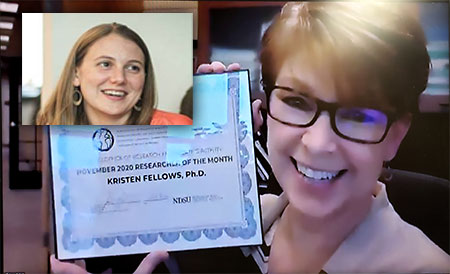 Kristen Fellows believes that researchers should always jump at collaborative opportunities because she sees each collaboration as an opportunity to gain valuable experience and they help a researcher really grow as a person. The NDSU anthropology professor has learned that the collaborations in her own career have had a direct impact on both her and her students.
Kristen Fellows believes that researchers should always jump at collaborative opportunities because she sees each collaboration as an opportunity to gain valuable experience and they help a researcher really grow as a person. The NDSU anthropology professor has learned that the collaborations in her own career have had a direct impact on both her and her students.
Fellows' research interests include historical archaeology, race and ethnicity, and enslaved populations. She studies the impacts of the African Diaspora, with a particular focus on the colonial era which saw mass numbers of people from Africa dispersed to the new world during the transatlantic slave trade. With a focus on Jamaica and the Dominican Republic, Fellows finds herself drawn to the rich history of the area. She has studied extensively the experiences, racial, and gendered issues of the enslaved people who were brought to work on the colonial plantations in the Caribbean.
"The slave trade in the Caribbean plantation system was both similar and different from what occurred in the United States at the time," Fellows said. "While wealthy whites comprised the ownership of the operations, a major difference was that they didn't run them directly." While most of these owners lived in distant locations such as England, out of necessity they had to utilize local mid-level management for day to day operations. This resulted in a somewhat different power structure than what was found in the United States' settler colonialism at the same time.
Fellows points out that her work helps to diversify the historical narrative and she has tremendous respect for the communities she studies. "Even in oppressive conditions, they still found ways to enrich their lives and build communities. They grew families and created art that has had an impact on our own culture today. I believe archaeology can play a role in giving them the credit they are due."
Fellows is also a believer in the power of involving students in her research. She provides both undergrads and Masters students experience working in archives with historical documents as well as participating in field work excavating sites for structural remains and artifacts. Given her research interest in the Caribbean area, she finds bringing students to work in that part of the world is especially rewarding.
"Not only do students learn from the historical record we uncover, but they also experience firsthand what it feels like to be outsiders in a culture where they are minorities in many ways," says Fellows. "Despite the many privileges they experience as American college students, the discomfort they sometimes feel helps to build empathy and understanding."
Originally from Gainesville, Florida, Fellows studied at the University of Florida and completed her graduate work at the University of Pennsylvania. Moving northward to NDSU, she found her research interests could even relate to stories from this area.
A recent research collaboration resulted in field work and the publication of a book entitled "Historical Sex Work: New Contributions from History and Archaeology." The book, edited by NDSU associate professor of history Angela Smith, University of Jamestown's Anna M. Munns, and Fellows features the story of Melvina Massey, an African America owner of the Crystal Palace brothel in Fargo during the late 1800s. First featured in a 2013 historical documentary created by Smith and her students called "Fargo's Most Notable Madam," Massey's story was compelling to Fellows.
"How does an African American woman end up in Fargo operating a successful business like the Crystal Palace? I just knew I had to be a part of telling this story," said Fellows. While Smith and her students worked on the historical story and biography of Massey, Fellows and her students used historical documentation and artifacts to piece together a picture of the space that was the Crystal Palace.
"The main floor of the building was designed for socializing. The women would spend a great deal of their time there with each other and their clientele before moving to the upper floors which were much more Spartan in design."
In addition to the layout of the business, Fellows found more details in the historical documents such as probate inventory listings from after Massey died. "Even though she was operating on the fringes of society, Massey was a savvy business owner and was well-known throughout the area. She provided money to a church near the Crystal Palace when they needed a new water system and when she died, the local newspaper reported on her death."
Fellows and her students also had the opportunity to conduct field work on the location in downtown Fargo where the Crystal Palace once stood. "When the City of Fargo was building the new Fargo City Hall, we were provided with backfill materials from the location. While we couldn't conduct a traditional field study and all context for the material was lost given it was mixed together, the material we received will continue to provide clues to this interesting story.”
Fellows is glad to have found a collaborative partner in Smith and notes that good collaborations like theirs often come when people have the space to pursue their own interests within the larger project. But she adds that finding someone with whom you naturally connect and enjoy is equally important as ideas just then seem to start bouncing around.
For being a researcher who knows the importance of uncovering the stories of forgotten but important parts of our collective history; for being a great collaborator, and for involving students in her research activities, we recognize Kristen Fellows as our November Researcher of the Month.
October 2020: Greg Endres, MS
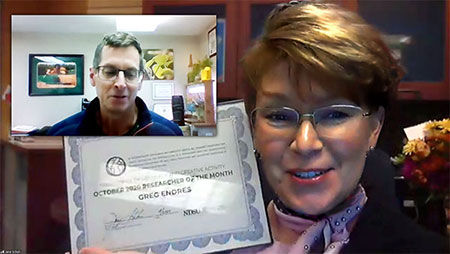 One strategy that Greg Endres has learned in his 30 plus years working as an agronomist at the NDSU Carrington Research Extension Center is that it’s important to be a specialist. During his tenure, Greg has worked on so many aspects of crops and crop management that relying on the special expertise of his colleagues and the work they are doing at the local plots is the best way to accomplish what he needs to do.
One strategy that Greg Endres has learned in his 30 plus years working as an agronomist at the NDSU Carrington Research Extension Center is that it’s important to be a specialist. During his tenure, Greg has worked on so many aspects of crops and crop management that relying on the special expertise of his colleagues and the work they are doing at the local plots is the best way to accomplish what he needs to do.
“I appreciate working at the Carrington Center,” he comments. “If I don’t have the answer, I can walk out my door and ask the scientists working here or I can go to the fields. The growing plots and the expertise of the people at our location create a true living laboratory that benefits the extension agents and growers in our area.”
Greg received his BS and MS degrees in plant science from North Dakota State University. He first worked for the NDSU Extension as an extension agent in Rolette and Ramsey counties and later as a cropping systems agronomy specialist at the Carrington Research Extension Center. Today he develops educational programs related to small grain and row crops with an emphasis on plant establishment, nutrition and protection primarily in south-central North Dakota. Greg considers Extension agents as his primary audience, but also serves crop advisers and farmers.
Greg’s time in Extension has given him an appreciation for the amount of work that goes into research trials. “Early in my Extension agronomy career, my supervisor Blaine Schatz encouraged me to spend up to 20% of time on research projects which has been a very positive part of my career. The research experience has provided valuable in-service training and has aided in better serving clientele.”
Keeping extension agents informed is a strategy that has worked well for Greg. He notes that communicating about the information the RECs develop is critical. To do this, he conducts conference calls and field tours throughout the summer to provide crop production updates. Greg and the agents will look at crops and talk about management activities that could be applied at various crop stages. As the Carrington REC conducts over 300 trials annually, releasing practical and timely information is challenging. Greg notes that Extension agents are key to this process of information delivery ultimately to serve farmers and crop advisers.
“When feedback from agents, crop advisers and farmers indicate the info transfer helped them, that’s very satisfying and what Extension is all about,” said Greg.
Collaboration is a major component of Greg’s work and he states that successful REC trials requires a team of research specialists and technicians from the initial start of a research study to the generation and collection of data to finally publishing the results. Along the way, he points to his relationships with the Extension agents as a critical component. “If they can see it live and then later read about the results in a report, there’s a better chance they may utilize the information in their daily work.”
Greg says his major success as an Extension agronomist has been soybean production research and education. While only a minor crop in the 1990s, soybeans became a major crop for North Dakota in the 2000s. Greg notes the combination of research and Extension working together helped growers and crop advisers during this time as soybean acreage exceeded spring wheat acreage in the state in 2016. “I’m pleased to have played a part in that growth and I’ve enjoyed delivering the information to growers that I’ve learned through trials.” Greg’s soybean work continues today: He recently started a project with Kendall Nichols, director of research for the North Dakota Soybean Council to determine the best soybean planting rate based on all the research previously completed
Over the last decade, Greg’s interest has also targeted dry edible beans because he points out that there is a need for updated and new production information. He is currently working on projects with REC research agronomists on pinto bean plant populations and rows, plant nutrition, and use of rye as a cover crop. Utilizing this data, they plan to soon release new recommendations for pinto bean production.
Greg is motivated to accomplish activities that ultimately help farmers and crop advisers. “Research is a lot of work but it’s fulfilling. Three to five years are needed to complete a research study and then we deliver the information as production recommendations. That’s the basic goal as an extension agronomist.”
We recognize Greg as our October 2020 Researcher of the Month for his consistency, tenure, and excellence in sharing research data with his colleagues and with the public.
September 2020: Yagna Jarajapu, PhD
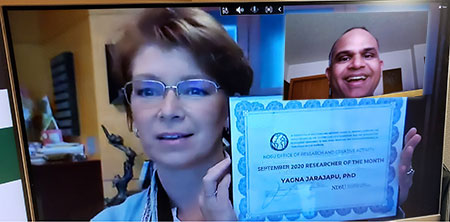 When he was first considering careers, Yagna Jarajapu, PhD, was interested in studying engineering. When it came time to choose a college, India’s Andhra University was the closest institution to his home. However, as only a handful of students were accepted into his favorite field of engineering at Andhra University, he decided to study pharmaceutical science instead. This decision proved to be a wise one as Yagna soon discovered he had an interest and passion for pharmacology. After completing his undergraduate work, he continued his education at Glasgow Caledonian University and the University of Strathclyde in the United Kingdom before post-doc appointments at Wake Forest University and the University of Florida. He came to NDSU in 2011.
When he was first considering careers, Yagna Jarajapu, PhD, was interested in studying engineering. When it came time to choose a college, India’s Andhra University was the closest institution to his home. However, as only a handful of students were accepted into his favorite field of engineering at Andhra University, he decided to study pharmaceutical science instead. This decision proved to be a wise one as Yagna soon discovered he had an interest and passion for pharmacology. After completing his undergraduate work, he continued his education at Glasgow Caledonian University and the University of Strathclyde in the United Kingdom before post-doc appointments at Wake Forest University and the University of Florida. He came to NDSU in 2011.
Yagna is currently an associate professor of pharmaceutical sciences at NDSU. His research interests of vascular physiology and pharmacology have led to his current work investigating the use of adult stem cells for diabetic patients to repair the damage done by the disease to their vascular systems. Yagna shares the alarming rates of diabetes today and the projections for the next decade. “According to the CDC, 34 million Americans today are diagnosed with the disease but 88 million are considered pre-diabetic. By 2030, those numbers are likely to double or even triple depending on how we act now.” Among certain groups the rates are even higher. “We are seeing disproportionate levels of diabetes in African Americans and Hispanics. Among Native Americans alone, up to 60% of the population have type 2 diabetes. Much of this is due to disparities in access to healthcare along with genetic factors and we are facing a true healthcare crisis in these populations.”
While diabetes is not difficult to treat when detected early, the long term effects of the disease are what Yagna is targeting with his research. Over time, complications of the vascular system in a person with diabetes can lead to catastrophic conditions including heart attack, stroke, chronic kidney disease or amputations. He points out that the economics of controlling the disease that could soon impact 1 in 4 Americans are best in the early stages as the latter stages of the disease require more extensive and expensive care.
Yagna’s research aims to help an individual’s body counter the long term effects of diabetes. While stem cell treatments have shown great promise in the treatment of cardiovascular diseases, the therapy’s effectiveness can be hampered by diabetes itself, therefore cell-based therapies are currently not feasible for diabetic vascular complications. Yagna is offsetting this issue by treating cells with certain peptides at a molecular level. He has shown that when injected in the body of a mouse, these modified cells will begin repairing the vascular damage and causing the patient’s dysfunctional cells to begin functioning again.
Apart from science, Yagna notes that there is an educational component that he stresses with his students. “I enjoy teaching in addition to research because we need more and more educators about the diseases our patients are suffering from.”
One of Yagna’s mentors, Mohan Raizada, PhD, from the University of Florida is a long-time researcher in the pharmacology of angiotensin peptides. Yagna credits Mohan with introducing him to the concept and inspiring him to research the peptides for protective effects in adult stem cells. Before that, he was inspired to study how the vessels functioned in diabetes by his graduate research advisor, Chris Hillier, PhD. He relates the story about how Hillier required him to go to emergency rooms and surgical theaters and wait outside during amputation procedures. “After the procedure was finished, the nurse would give me some tissue which I would take back to my small lab and dissect under microscope to isolate tiny blood vessels known as small arterioles of caliber 100-200 microns. Not many students were willing to wait for specimens in this manner, but I appreciate that my advisor required me to do this and the expertise I gained by working on this project.”
Yagna states that one important aspect he’s learned in his career is that project management is critically important. “If you like your research, you will figure out how to do it. But you have to learn how to be a good project manager. For example, in my research, the aging process in the mice is accelerated, as in humans, once they have developed diabetes. They will soon die. You need to manage the animals and schedule effectively or you can’t complete your research.”
Collaboration has also been important to Yagna’s research. He points out that collaborations can be done with anyone both in his immediate team and outside of his discipline. He’s worked with researchers across campus in both exercise physiology and polymers and coatings. “There are so many ways to collaborate. Sharing ideas is collaboration as much as sharing experimental models and I like to do both.” The clinical component of his research is critical for defining the translational potential of the findings, and is currently being accomplished in collaboration with Dr. Charles Garcia, MD, an ophthalmologist based in Houston, Texas.
Yagna tells young researchers to always keep an open mind and look for alternative ways and means to answer scientific questions. Learning from failures is the key for success. He believes that once you learn the right tools and mindset, they can be applied to any field of science. For being both an educator and a researcher, we recognize Yagna Jarajapu as our September 2020 Researcher of the Month.
February 2020: John Wilkinson, PhD
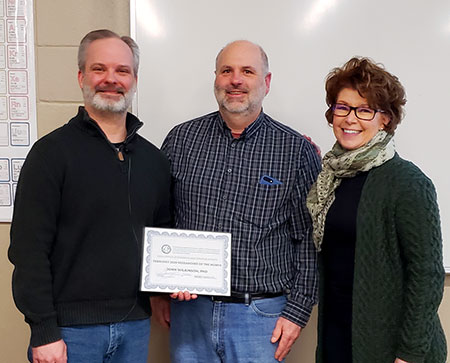 John Wilkinson first became curious about just how cells work at a young age. He remembers learning about how mitochondria powers the functions of cells from a character in Madeleine L’Engle’s book A Wind in the Door and meeting the author when he was 13 really solidified this passion. The associate professor of biochemistry at NDSU remembers that it was at this time he became really curious not only about how cells work, but how they don’t work and what happens when they break down.
John Wilkinson first became curious about just how cells work at a young age. He remembers learning about how mitochondria powers the functions of cells from a character in Madeleine L’Engle’s book A Wind in the Door and meeting the author when he was 13 really solidified this passion. The associate professor of biochemistry at NDSU remembers that it was at this time he became really curious not only about how cells work, but how they don’t work and what happens when they break down.
John’s curiosity led him to biology and science classes in high school but after graduation he changed his plans and decided to study law. However, the lack of a pre-law program at Florida State University turned him in yet another direction so he took his advisor’s advice that an undergraduate degree in life sciences would be a good foundation for law school. It was during his first biochemistry class that John found he was still passionate about cell functions so he decided to follow that path.
After completing his BS in biochemistry, he received a PhD in molecular biology from Vanderbilt University. Following postdoctoral training at the University of Michigan, he started his faculty career at Wake Forest before coming to NDSU.
“I like the environment at NDSU and how I get to interact with a number of both graduate and undergraduate students in the lab,” he commented. “In addition, the opportunities to collaborate with other researchers is key to my work.”
John studies cancer. “While there are thousands of different types in just the categories of prostate and pancreatic cancer, all forms of cancer share the feature of uncontrolled growth patterns and this growth requires individual cancer cells to use energy differently than healthy cells,” he said. “The proliferation of tumorous tissue also creates different types of biological stress on a body and when such conditions of low oxygen or blood flow exist, the resulting stress can cause the tumors to become aggressive.”
“We all know someone affected by cancer so everyone gets the ‘why’ behind my research,” John continued. “However, how cancerous tissues create and use energy is what really interests me.” Harkening back to his early interest in mitochondria’s role in cells, John began looking at the proteins that impact and promote its function in the cell. “At Wake Forest, I became really interested in one protein, called apoptosis inducing factor (AIF), that promotes prostate cancer progression by regulating mitochondrial energy production.”
First identified in the late 1990s, AIF plays a role in triggering the process that leads to a cell’s death. It also serves an important role in helping mitochondria produce energy for the cells. “Think of mitochondria as a gasoline engine and AIF is like motor oil,” said John. “All engines need oil, but in only the right amounts. Too little and the engine will seize up but too much and it will overheat. In cancerous cells, there must be the right amount of AIF. If you take it away completely, the cell dies.” John’s research is hoping to develop treatments that will target and limit AIF in only cancerous cells.
John’s lab is open to both undergrad and graduate students. He is a supporter of initiatives such the undergraduate showcase NDSU EXPLORE and enjoys how NDSU provides an opportunity to work with students at all levels of their education. “I appreciate working with students and helping them develop into effective scientists,” he noted. John sees a need today to really drive home concepts like ethics, integrity, and trust in science with his students. “Acceptance of truth is challenged today more than ever. It’s never been easier to manipulate data and the resulting temptation is stronger than ever. I tell them that every lie is a debt to the truth and will need to be consolidated eventually. I spend time with my students discussing their ethical responsibility to truth and repeatability in science.” John refers to effective data recording as “keeping the receipts” of research.
John’s advice for new researchers is simple. He never assumes he is right nor that he’s the smartest person in the room. “That way, all my attention can be focused on looking for and proving the truth.” This attitude has helped him in finding collaborators. John currently works with pharmaceutical sciences professor Sanku Mallik and civil engineering distinguished professor Kalpana Katti at NDSU.
John recommends researchers be open minded; open to making mistakes (or “redirects” as he calls them); and to work in smart ways. “I tell my students to do the critical thinking at first when designing experiments. When you’ve prepared everything, you can then let it roll.”
For being a good scientist and communicator who’s helping students see the value of truth and a solid research methodology, we recognize John Wilkinson as our February Researcher of the Month.
January 2020: Rajani Ganesh-Pillai, PhD
If you ask Rajani Ganesh-Pillai about the key to successful marketing, she'll pause, look you in the eye and tell you what it isn't. Rajani doesn't think marketing should be only about making money or convincing customers to buy something new. Instead, she believes marketing is about understanding people and finding out what problems they are trying to solve and then finding solutions to those problems through products, services, and ideas. Rajani researches consumer behavior as an associate professor of marketing at NDSU.
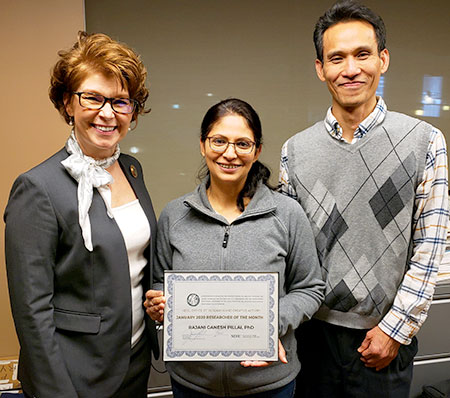 "My research is about what leads people to make decisions in the face of risk and uncertainty in their lives such as where they live, what they do for a living, and who their life partners are," she says. "While it also includes what products they buy, I see consumer behavior as a broad topic that intersects with behavioral economics, psychology, and sociology. My research is interdisciplinary and is guided by my curiosity about human behaviors."
"My research is about what leads people to make decisions in the face of risk and uncertainty in their lives such as where they live, what they do for a living, and who their life partners are," she says. "While it also includes what products they buy, I see consumer behavior as a broad topic that intersects with behavioral economics, psychology, and sociology. My research is interdisciplinary and is guided by my curiosity about human behaviors."
Rajani believes that a lot of what drives consumers when judging new products is perceived risk. "Innovative products are risky to consumers," she says. "They're different and they offer something new and that creates uncertainty.
She relates how one of her current projects involves the perceived value of nano zinc oxide in sunscreen and how companies present their value in their marketing. "If a product has too much mineral zinc oxide, it remains white and chalky on the skin. If there's too little, it's not effective at blocking the sun. After a product with too little concentration of mineral zinc oxide allowed sunburns to happen, we saw a change in positioning. Some companies began promoting nano zinc oxide as feature that provided added benefit. While other companies positioned their sunscreens as 'natural' or with 'mineral zinc oxide,' nano particles were there all along. But its framing in communication to consumers was intended mitigate the perceived risk. Same product, but a completely different approach."
Rajani collaborates with many researchers and groups at NDSU. She has worked with William Nganje (professor and chair of agribusiness and applied economics) on innovations in food technologies and with Achintya Bezbaruah (associate professor of civil and environmental engineering) on the perceived and objective risks among farmers regarding nanoparticles in fertilizers. She's also a member of the Center for Engineered Cancer Test Beds Grand Challenge where she works with Elizabeth Crawford Jackson (associate professor of communication) to understand how message strategies influence perceived risk and acceptance of nanotechnology based cancer test beds. Rajani also serves as a Challey Fellow where she investigates innovation and development. Her research has appeared in journals including the Journal of Business Research, Journal of International Marketing, Thinking & Reasoning, and Journal of Nanoparticle Research.
"My advisor once told me that good collaborators can either make or break your research," she said. "I've found that the best way to approach a potential collaboration is to connect with the fellow researcher as a person first. Whether it's at a social event or over a cup of coffee, the best collaborations I've had start from a place of mutual respect and a great problem that we can solve together."
Rajani relates how collaboration has expanded how she perceives ideas. "When I was a child we learned the old story of the three blind men and an elephant. The one who felt the trunk thought the creature was a snake while the one who felt the foot thought it was a tree and the other who felt the side thought it was a wall. They could only see what they could feel. This is exactly how my work with professor Nganje has broadened how I perceive risk. To me, it's always been a perception or a feeling but to him, it's a hazard that can be estimated. After working with him, I see the concept of risk more like a Venn diagram with distinct areas that cross over and those intersections are interesting to me."
As a Challey Fellow, Rajani is concentrated on studying how sustainable product design impacts a firm's marketing and economic performance; the adoption of innovations in food and agriculture and how this may be influenced by innovation resistance of adopters; and how institutions of higher learning influence cluster performance and economic development. "My time as a Challey Fellow has given me even more opportunity to work with people from across a wide range of disciplines who are all interested in entrepreneurship and innovation. When we break away from our everyday concerns our projects become even better," she adds.
From a young age, Rajani has always been a person that asked "why." After getting an undergraduate degree in biology, she carried that scientific questioning mentality with her. "When I was working in marketing and communications, I questioned everything until one day, my supervisor got frustrated and suggested that if I wanted the answers, I should go get a PhD. So I did. Behaviors that impact people's lives have always been interesting to me and I will always wonder about what drives them."
Rajani's advice to new researchers is simple: "While there's so much that you have do, don't become insulated. Make connections and meet people. Join groups and take advantage of opportunities to connect. Other people will help you see things in new ways -my collaborators at NDSU have made me a better researcher."
For showing the value of collaboration and for always looking for new ways to look at a problem, we recognize Rajani as our January 2020 Researcher of the Month.
November 2019: Chad Ulven, PhD
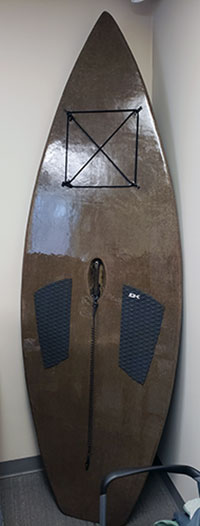 As you glance around Chad Ulven’s office, it’s not difficult to see how ubiquitous his bio-composite products can be. Whether it’s the bicycle helmets, the hockey stick, the pickleball paddle, or the 6 foot plus tall paddleboard propped up in the corner, it’s apparent that this NDSU mechanical engineering professor’s work comes in many varied forms. Created using natural fibers, Chad’s products are more sustainable replacements for traditional petrochemical products.
As you glance around Chad Ulven’s office, it’s not difficult to see how ubiquitous his bio-composite products can be. Whether it’s the bicycle helmets, the hockey stick, the pickleball paddle, or the 6 foot plus tall paddleboard propped up in the corner, it’s apparent that this NDSU mechanical engineering professor’s work comes in many varied forms. Created using natural fibers, Chad’s products are more sustainable replacements for traditional petrochemical products.
A love for mechanics brought him to NDSU, where he earned his BS. Afterwards, he went to graduate school at the University of Alabama at Birmingham and worked for a summer as a research scholar at the U.S. Army Research lab in Aberdeen, MD. Chad notes how it was at this time that he developed his interest in traditional composite materials made from advanced fibers such as carbon and Kevlar. He soon concluded that developing similar composites from renewable materials represented a way for him to improve certain attributes of items (such as vibration dampening) and create ecologically-friendly products.
 When he was an undergraduate student, Chad found his first research opportunity through a classmate. “When I looked at it, it was a better job than the one I had so I joined his lab.” Soon he was making composite materials for armor. “That undergraduate research experience showed me the path I wanted to follow and got me to the University of Alabama at Birmingham and soon after graduation, the NDSU position opened up.”
When he was an undergraduate student, Chad found his first research opportunity through a classmate. “When I looked at it, it was a better job than the one I had so I joined his lab.” Soon he was making composite materials for armor. “That undergraduate research experience showed me the path I wanted to follow and got me to the University of Alabama at Birmingham and soon after graduation, the NDSU position opened up.”
Fourteen years of research in both flax and hemp based biocomposites at NDSU have proven that he is on the right track. Chad is currently the principal or co-principal investigator of six research projects related to composite material development totaling over $3.5 million. In 2014 he cofounded c2sensor, a company that develops sensors for agriculture that provide soil condition data such as moisture and salt levels to readers that are passed over them. Both biodegradable and inexpensive, the sensors give agriculture producers a simple method to monitor their soil health. A sister company called c2renew develops consumer products using the same bio-based technology.
Early on in his career, Chad began a relationship with the Composites Innovation Centre in Winnipeg. Still working with them today, he notes how federal support for this type of research is also critical to its success. He points out how the most recent U.S. farm bills have changed the language from biofuels to bio products to now include industrial hemp. He believes this transition has opened up funding from agencies including the National Science Foundation, U.S. Department of Agriculture, and the Department of Defense for his type of work.
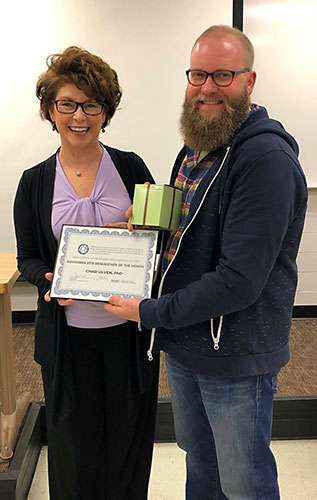 “I’m never satisfied…I’ve always been that way,” Chad says. While he’s quick to add that he’s not a perfectionist, he believes he can always improve on his ideas. “I like to think that every idea can get better but I see too many times when researchers want to perfect something before commercializing it. I’m an experimentalist. My philosophy is to show and grow.”
“I’m never satisfied…I’ve always been that way,” Chad says. While he’s quick to add that he’s not a perfectionist, he believes he can always improve on his ideas. “I like to think that every idea can get better but I see too many times when researchers want to perfect something before commercializing it. I’m an experimentalist. My philosophy is to show and grow.”
This was apparent to Chad when he started his businesses. “My first pitch meeting with investors was an eye-opener to me,” he relates. “My background, my knowledge, and my science didn’t really matter. Instead, they just wanted a two minute pitch about how they could make money with my idea. Through this process I learned that I had to prove myself and come up with answers like ‘who cares?’ before I went in front of investors. Today I help my students understand that methodology in my entrepreneurial class.”
Chad points out that at his place in his career, he knows he can’t do everything on his own. “Being involved in so much, it’s important to know when something is good enough to go versus reworking it over and over again.” He looks for attributes like this in his partners and collaborators too. “I look for people who want to work equally as hard as I do and who are passionate about developing tech that can change the world.” Whether it’s in his research or businesses, he looks for people whom he can rely on to push ideas forward.
Chad’s sums up his advice in a simple way. “Be open and visualize something that will stretch your comfort zone,” which is where he believes he’s at his best. “I don’t like being comfortable – I need to be uneasy to innovate. For that reason, I’m constantly trying to make myself nervous to get me into that innovation zone.”
For all that Chad Ulven does for the science of composites and engineering along with his ability to help others see beyond, we recognize him as our November 2019 Researcher of the Month.
October 2019: Rooth Varland, MFA
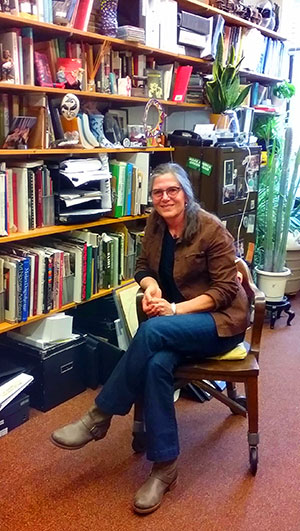 Rooth Varland believes in the value of good theatrical literature and how it brings together artists to collaborate in a shared community experience of writing, music, and design. The NDSU professor and costume designer for NDSU’s Little Country Theatre has been doing just that throughout her career and this school year marks her 20th at NDSU. In addition to her time here, Rooth has also designed costumes for premier productions in Norway, Georgia, Mississippi, Minnesota, Kentucky, and Tennessee.
Rooth Varland believes in the value of good theatrical literature and how it brings together artists to collaborate in a shared community experience of writing, music, and design. The NDSU professor and costume designer for NDSU’s Little Country Theatre has been doing just that throughout her career and this school year marks her 20th at NDSU. In addition to her time here, Rooth has also designed costumes for premier productions in Norway, Georgia, Mississippi, Minnesota, Kentucky, and Tennessee.
Rooth sees her work in theatre arts as a synthesis of design, coaching, and production that gives her students an opportunity to understand the overall art of theatre dress and décor. By utilizing aspects of the research process in determining historical accuracy of design and materials, she feels that she is providing her design students an understanding that goes beyond the walls of the theatre. “I believe one of the most important contributions of my research is helping others to see new things,” she says. Her research tools are primarily books and digital resources although at times she has also enlisted individuals with special knowledge for detailed costumes such as military uniforms. In addition to costuming, she also teaches courses in the history of dress and décor and dramatic literature.
Rooth received an MFA in Theatre Design from Northwestern University in 1988. In 1995, she was a National Endowment for the Humanities (NEH) fellow at the Center for 20th Century Studies at the University of Wisconsin–Milwaukee. At the Center, considered to be one of the nation’s first humanities research centers and a destination for some of the world’s foremost artists and thinkers, Rooth studied postmodern performance theory with Herbert Blau, an American director and theoretician of performance. In 2003, she was the recipient of the Kennedy Center American College Theater Festival Fellowship for designers. Rooth has also served as resident designer at 7stages in Atlanta, where she collaborated with theatre legend Joseph Chaiken. As a member of United Scenic Artists Local 829 (Chicago), Rooth is the only union designer in North Dakota.
A self-proclaimed introvert, Rooth enjoys how her work gives her an easy way to both connect with others and express herself. “Modern communities of people don’t come together as often as they used to,” she notes. “Communal activities used to be much more woven into our lives which allowed us to experience things together. Theatre is a communal activity that really hasn’t changed that much and the process of creating environments for others to experience really drives me.”
 Rooth approaches her work with a consistent method she’s developed throughout her career. She first plots out a show from the script and looks for the highs and lows of the action and thinks about what the playwright is trying to get the audience to see. Next, she determines what is important in the costuming for the show and what styles and materials would be help deliver the messages. Then she moves into a phase of researching time periods and styles and creating drawings that begin as rough designs but are slowly fleshed out with the addition of color palettes, textures, and fabrics. Finally, she creates the actual costume pieces. Throughout the process, she works in conjunction with the scenic and lighting designers to ensure consistency.
Rooth approaches her work with a consistent method she’s developed throughout her career. She first plots out a show from the script and looks for the highs and lows of the action and thinks about what the playwright is trying to get the audience to see. Next, she determines what is important in the costuming for the show and what styles and materials would be help deliver the messages. Then she moves into a phase of researching time periods and styles and creating drawings that begin as rough designs but are slowly fleshed out with the addition of color palettes, textures, and fabrics. Finally, she creates the actual costume pieces. Throughout the process, she works in conjunction with the scenic and lighting designers to ensure consistency.
All of Rooth’s theatre students create a capstone project comprised of a multi-step design process. Each student identifies a deficit in a skillset or a challenge they want to take on and then develops a research project to address it. Students document both their challenge and the path and process they followed in papers throughout their capstone projects.
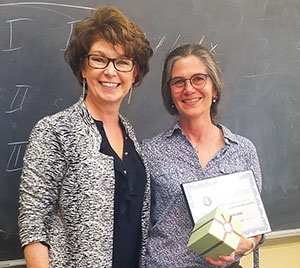 Rooth works with students from all majors, but theatre and fashion design students typically are the ones creating the actual pieces in the costumer shop. “Many of today’s students come from environments where they never learned how to make things when they were younger and they get really excited when they can do so for a project,” she notes. “I feel like we are filling a gap and teaching them a process they can use in many areas throughout their lives.”
Rooth works with students from all majors, but theatre and fashion design students typically are the ones creating the actual pieces in the costumer shop. “Many of today’s students come from environments where they never learned how to make things when they were younger and they get really excited when they can do so for a project,” she notes. “I feel like we are filling a gap and teaching them a process they can use in many areas throughout their lives.”
When thinking about her philosophy, Rooth lives by the advice her father once gave her. He told her to be a breath of fresh air. “I try to always do that. Nobody wants to deal with a critic all the time. I want to be the person who is coming up with a fresh, positive approach.”
For her dedication to research in her craft and to her colleagues and students, we recognize Rooth Varland as our RCA Researcher of the Month for October, 2019.
September 2019: Susan Ray-Degges, PhD
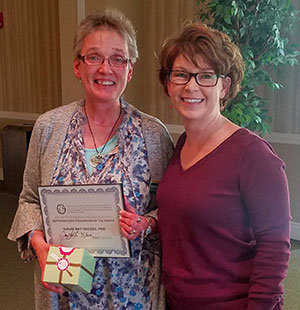 Susan Ray-Degges is a professor and interior design program coordinator at NDSU. She began teaching at NDSU after receiving her master’s degree in housing and interior design and her doctorate degree in human environmental sciences from the University of Missouri. Her tenure at NDSU spans nearly three decades and she is considered a mentor for both students and faculty, including designers outside of NDSU. Susan was recently honored as a fellow of the American Society of Interior Designers, a group that she’s been a member of since 1987. Considered the society’s highest honor, less than 1 percent of the society’s membership are named as fellows.
Susan Ray-Degges is a professor and interior design program coordinator at NDSU. She began teaching at NDSU after receiving her master’s degree in housing and interior design and her doctorate degree in human environmental sciences from the University of Missouri. Her tenure at NDSU spans nearly three decades and she is considered a mentor for both students and faculty, including designers outside of NDSU. Susan was recently honored as a fellow of the American Society of Interior Designers, a group that she’s been a member of since 1987. Considered the society’s highest honor, less than 1 percent of the society’s membership are named as fellows.
A certified interior designer, Susan believes in fully preparing students for the workforce. While her coursework aims for a high level of proficiency in the skills required to be a successful interior designer, Susan also stresses the need for real world experience and a capstone research project. “I tell my students that they’re not decorators, but designers and that the research they put into their work matters. Having the skills to support the decisions they make will be critical to being both technically proficient and successful in getting work and earning repeat business,” she said.
All interior design students must complete an evidence-based research project in their final year. While research of this level is not required by accreditation, Susan notes how important it is in creating designers who are truly ready for the workforce. Conforming to all traditional elements of research, these projects include data collection surveys, information reviews, user groups and working with the IRB team to ensure all research meets human subject compliance standards. “Basically, we’re offering a master’s level of educational experience for our undergrads,” Susan points out.
An example of one these research projects is the A. Glenn Hill Center. After the building was initially opened, staff noticed that some of the tables placed in the common areas for student use were being moved to new spots. The students conducted a study involving observation to learn how students used the space. The results were compiled into a research presentation shared at a national conference. This project is exactly the type of experience Susan wants her students to have. “You’re no good until you practice. Real world experiences mean that our students can move immediately into practice after graduation.”
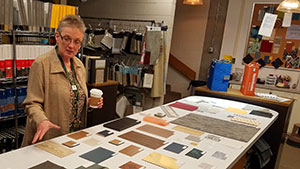 Susan publishes her own technical reports, articles, and programs for use by other educators. She has presented about her programs at national conferences and has provided guidance for a similar program at the University of Minnesota. Mentoring is important to Susan and she incorporates the concept into her relationships with both new faculty and students.
Susan publishes her own technical reports, articles, and programs for use by other educators. She has presented about her programs at national conferences and has provided guidance for a similar program at the University of Minnesota. Mentoring is important to Susan and she incorporates the concept into her relationships with both new faculty and students.
Her research focuses on the effects of interior design on the elderly. She has worked on a project for use by North Dakota Extension that has the goal of helping people stay in their homes as long as possible. She is also working in collaboration with gerontology extension specialists in North and South Dakota on a housing study examining older adult knowledge and preferences for aging in place.
Susan also believes in providing hands on studies for her students in addition to research projects. She places her students in six week internships with unique cultural experiences in locales including China, California, Florida, Ireland, and Minneapolis. “Our goal is to get students out into the community and to make sure they are prepared for the kinds of rigorous problem solving they’ll face in their careers.” In addition, every two to three years Susan and a colleague take students on trips to Helsinki, Stockholm, London, Paris, and Amsterdam to let them experience classical design disciplines, architecture, and interior designs.
Susan Ray-Degges believes that experience and research methodologies are the best manner to prepare her students for lifelong careers. “You can’t teach if you haven’t practiced,” she states. For her dedication to the education process and to conducting research within her discipline, we recognize Susan as the September 2019 Researcher of the Month.
April 2019: Fred Riggins, PhD
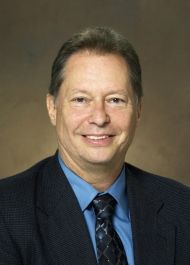 Before earning his doctorate in information systems at Carnegie Mellon University, Fred Riggins worked at Boeing as a cost analyst negotiating software procurement contracts with suppliers. In this role he learned firsthand the concept of network externalities. An externality is where each subsequent user of a system adds value to it. “Think of a telephone,” he says. “If you only have one, there’s no value, but every unit you add increases the overall value of the system.” Fred sees the same concept within one of his areas of interest and expertise: blockchains.
Before earning his doctorate in information systems at Carnegie Mellon University, Fred Riggins worked at Boeing as a cost analyst negotiating software procurement contracts with suppliers. In this role he learned firsthand the concept of network externalities. An externality is where each subsequent user of a system adds value to it. “Think of a telephone,” he says. “If you only have one, there’s no value, but every unit you add increases the overall value of the system.” Fred sees the same concept within one of his areas of interest and expertise: blockchains.
Fred is a professor of management information systems at NDSU and the director of the Center for Enterprise Business Analytics at the university. With a career that spans time at Georgia Tech, the University of Minnesota, and Arizona State University, Fred has been ranked as one of the top 10 IS researchers in the world. His research interests include blockchain technology, the economics of information systems, the Internet of Things, and Internet commerce technology and how these systems impact people. Fred feels that at NDSU he’s found the perfect place for both his teaching and research.
While IT research has not often considered the human element as a primary concern, Fred believes that today it should be fundamental to research. “Management and economics are both very social concepts. While I never thought of myself as a social scientist, today I consider myself one. It’s becoming more important to think how we can empower each individual to make choices that will make the world a better place.”
Gesturing out the window, Fred says, “Look out there and tell me what you see that’s moving. Everything moving is most likely controlled by humans, but will most likely become autonomous in the near future. How that will impact society is something that’s truly worth thinking about.”
Fred is thinking much deeper than merely self-driving vehicles. He shares an image of how technology will change the very basic structure of society. “Imagine a scenario that’s beyond the concept of companies like FedEx and Amazon using autonomous vehicles for deliveries. Say that after a snowstorm occurs, a robot moves through your neighborhood and negotiates with your house about snow removal. An agreement is reached between the two, a service is provided and a fee is collected. The transactions that occur in this manner will eventually automatically direct income back to the owners of the devices.” In order for this scenario to occur, there is a need for a consistent, secure, and trustworthy foundation. This is where blockchain comes in.
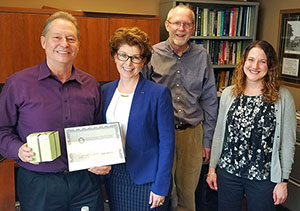
Fred describes a blockchain as a series of linked records with some data in the blockchain encrypted and some is available for everyone to see. When a new record is created, the link to the previous block ensures that it can’t be modified without changing the total chain. Fred likens a blockchain to the same general ledger shared among a large group of partners. He notes how using it removes the responsibility for transactions to go through a trusted centralized source (like a financial institution) and it allows transactions to occur widely across each individual using it. “The first blockchain was created in the late 2000s as bitcoin and was a product of the cypherpunk movement of that time. It was meant to serve as a method to trade cryptocurrency without the need to work through a centralized bank.” Building on this idea, Fred plans a research project for this fall that will look into the subject of what is money and what gives it value.
While the blockchain distributed model is the basis for cryptocurrency, Fred appreciates its other uses. “IBM and Walmart have been working on a food supply blockchain called the IBM Food Trust Solution,” says Fred. “By recording all the points our food takes from farm to our homes, we can immediately know where issues such as contaminations have been introduced. There is great potential for improving our food safety by utilizing blockchain technology in this way.” Looking further out, he adds how this system could provide consumers with additional power over their purchases. “Let’s say you get some orange juice that tastes really good to you,” he says. “You can scan the bottle and immediately know the original source thanks to the blockchain. Then, the next time you’re shopping, you’ll use an app on your smartphone to be able to find and buy the product from that very same source again.”
Beyond the value of blockchain, Fred sees a future changed by autonomous systems that are openly managed by everyone. The systems of Fred’s future will be self-managing microbusinesses that interact with each other independently to provide services on our behalf and efficiently transfer their profits back to their owners.
Fred’s vision is far from a dystopian one. In fact, he’s optimistic about the power of individuals and how they will navigate and explore this new world. He’s also fascinated by how technology can make the world better. Fred believes that when you put those two ideals together, everyone is in the position to change the world for better. “Like the organization Kiva,” he says, “which is a crowdsourcing non-profit that allows people to select and invest in global startups of all kinds, we need to develop tools that will help us create the world we want to live in.”
He shares these ideals with his students and hopes they adopt them. When talking about the future, he asks students, “Is this the world you want to live in?” Regardless of their answer, he knows he’s moved their thoughts and ideas to a new time and place where they can begin to have a positive impact.
For being both a researcher and proponent of a better future world, Fred Riggins is our April Researcher of the Month.
March 2019: Rajesh Kavasseri, PhD
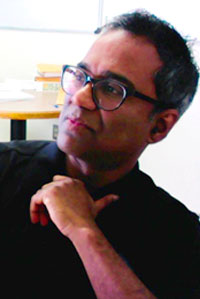 Dr. Rajesh Kavasseri is a professor and graduate coordinator in the department of Electrical and Computer Engineering and is an expert in electric power systems and smart and connected communities. He’s been at NDSU since earning his PhD in Electrical Engineering from Washington State University at Pullman, Washington in 2002.
Dr. Rajesh Kavasseri is a professor and graduate coordinator in the department of Electrical and Computer Engineering and is an expert in electric power systems and smart and connected communities. He’s been at NDSU since earning his PhD in Electrical Engineering from Washington State University at Pullman, Washington in 2002.
While our power grids are immense systems that drive incredible amounts of energy across vast distances, Rajesh notes that they are often taken for granted. “The grid is not just a bunch of wires and towers, behind it is a massive computational engine that manages electric power which moves at the speed of light,” he says. “Though robust for the most part, it could be fragile at times, especially when stressed”. Much like a set of dominos, if you knock one down, a sequence of events could occur that could jeopardize the entire grid. We are trying to make them resilient so they can learn from their problems, continually gauge, and correct their own operation.”
Rajesh’s concept of smart systems is framed in two components of his research philosophy. He believes that people know when they are wrong with much more confidence than when they are right. He also believes in second chances. While everyone and every system will have faults, they are not as important as the resulting action to correct them. “We are hardwired to listen to our internal compasses that tell us right and wrong. And when we are wrong, we usually know it and we are able to redirect and change course or action. We are integrating these ideas into systems so that they can become resilient.”
Resiliency as a concept provides a wider base of operation for a system as it allows for constant identification and correction of errors. Resilient systems monitor their activity and make selective decisions when they need to adjust to a mistake or bend the rules a bit. “Think of it like a team of football referees,” says Rajesh, “You have a crew watching play on the field but if they miss a call, the booth can jump in and correct the error. All work in harmony to ensure the right calls are made.”
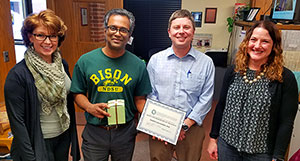
This sort of common sense engineering has been possible by technology that has allowed more wider data streams to be accessed and processed faster than ever before. But Rajesh doesn’t expect to see it widely adopted at first. “While power systems have been smart for some time, the concept of resilience is somewhat new. Given the risk-averse and conservative nature of the electric utility industry, it can sometimes take decades for radically new technical concepts like this to be generally accepted and implemented.”
The concepts of knowing right and wrong and giving second chances are more than just research concepts to Rajesh. He believes that nothing is more diverse or surprising than the paths we take in life and he welcomes the experiences and changes that they bring to him. “I have always looked forward to the ‘ah-ha’ moments that life gives me and I’ve learned from them all, regardless of whether they were positive or negative to me,” he said.
Rajesh has been working on an NSF-funded project to develop Smart and Connected Communities. The work has involved collaborators from multiple disciplines including power electronics, electrical materials, architecture, landscape architecture, and visual arts along with five graduate students. The team hopes to learn and develop living spaces that are smart and utilize passive technology to improve power consumption. Rajesh enjoys these types of collaborations because they provide him with insights he may not normally get. “I usually look for collaborators with diverse interests who have a little bit of a maverick streak in them - because that keeps it interesting!” The project has targeted remote and rural communities in North Dakota as they have the same environmental issues that are found across the world.
Both a leader and a collaborator, Rajesh tells new researchers to dream big, to dream wide, and to not be afraid to follow their own curiosity. He shies away from doing what everyone else is doing, or as he puts it, “don’t follow the research herd…have a plan and make it your own.”
For being both a researcher and proponent of the type of mindset that supports research, Rajesh Kavasseri is our March Researcher of the Month.
February 2019: Molly Turner, PhD, MS, RN
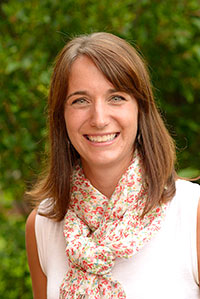 Molly Secor-Turner, PhD, MS, RN is an associate professor in the NDSU School of Nursing and Master of Public Health (MPH) Program in the Community Health Sciences track. Both a teacher and researcher, Molly earned her Ph.D. in nursing from the University of Minnesota in 2008, serves as the NDSU Faculty Senate President-Elect, and is an adjunct faculty at the Center for Health Outcomes and Prevention Research at Sanford Research.
Molly Secor-Turner, PhD, MS, RN is an associate professor in the NDSU School of Nursing and Master of Public Health (MPH) Program in the Community Health Sciences track. Both a teacher and researcher, Molly earned her Ph.D. in nursing from the University of Minnesota in 2008, serves as the NDSU Faculty Senate President-Elect, and is an adjunct faculty at the Center for Health Outcomes and Prevention Research at Sanford Research.
A self-proclaimed advocate of social justice, Molly’s work spans more than a decade. She has strived to bring attention to how societal contexts impact the methods and manners in which society talks to adolescents about sexuality. Reflecting on her work and worldview, Molly simply says, “I believe everyone is innately good.” She also strongly believes in the value of the shared humanity among people regardless of their geography, gender, age, or other delimiters.
Molly notes that this awareness causes her to continually examine teaching and research methods. “For example, as recently as only a decade ago, youth sexual health education messages didn’t consider a LGBTQ perspective. Often the messages were focused on abstinence until marriage and marriage wasn’t even an option for this population. All it did was turn them off to the rest of our information. It was important to restructure our approach based on where the youth were coming from and to be more inclusive to all individuals.”
Molly has spent her career ensuring science benefits everyone. When working on her dissertation at the University of Minnesota, she studied how low income teenage youth deal with pregnancies. At the same time, she was starting her own family and she found that despite the differences between her and the teens, both were driven for the same outcomes. “Despite age or financial standing, everyone wants to succeed as a parent. Nobody wants to be a bad parent. I saw so much similarity among these young mothers and in myself and that experience really had an impact on me.”
Soon after, Molly found an opportunity in Kenya to make an impact in the lives of another set of young women. “In that part of the world there has historically been a lack of information and materials about menstruation. Girls experiencing their periods would often not be able to attend school. As education is a predictor for good health outcomes, missing time in school began a downward spiral for these women that would negatively impact them the rest of their lives. So we broke the cycle by providing them what they needed to remain in school.” Molly started For the Good in 2015 and currently serves as Program Director for the organization. Originally, they prepared and shipped washable, reusable menstrual materials to adolescent girls in rural Kenya. But in 2017, the organization shifted to a local focus with employees in country. Molly is happy to see this change as it shows how her organization has made an impact in the mindset of an entire community.
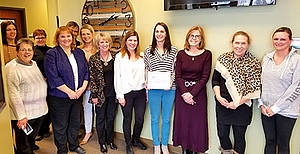 Molly is a believer in the power of groups as evidenced by her considerable involvement with community organizations including the North Dakota Center for Nursing, Midwest Nursing Research Society, the Society for Adolescent Health and Medicine, the Sanford Women’s Comprehensive Health Clinic Community Advisory Board, and the Planned Parenthood North Dakota Advisory Committee. She notes how her work has flourished through collaborative partnerships, including with a public health nurse in Kenya, NDSU’s Brandy Randall, and other faculty members at the University of Colorado and the University of California, Davis. She sums it by saying, “I prefer to collaborate. Everyone adds a unique perspective.”
Molly is a believer in the power of groups as evidenced by her considerable involvement with community organizations including the North Dakota Center for Nursing, Midwest Nursing Research Society, the Society for Adolescent Health and Medicine, the Sanford Women’s Comprehensive Health Clinic Community Advisory Board, and the Planned Parenthood North Dakota Advisory Committee. She notes how her work has flourished through collaborative partnerships, including with a public health nurse in Kenya, NDSU’s Brandy Randall, and other faculty members at the University of Colorado and the University of California, Davis. She sums it by saying, “I prefer to collaborate. Everyone adds a unique perspective.”
Including both undergraduate and graduate students in research also provides Molly with additional important perspectives. “Nursing research is unique as it’s typically a practice discipline. I like to show my students how to practice curriculum from beginning to end by both working and researching. I’ve had many good mentors in my career, especially in my early years, and they’ve helped me to see that collaboration truly multiplies effectiveness. I also strive to convey to students that it’s okay to fail. Don’t be afraid to try something new and fail at it. This is how we get better at article submissions, proposals, research projects, or anything you attempt.”
For her many contributions to health education and research, Molly Secor-Turner is our February Researcher of the Month.
December 2018: Sherri Stastny, PhD
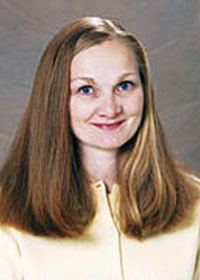 Sherri Stastny is a professor in the department of Health, Nutrition and Exercise Sciences at NDSU. She’s a researcher, a registered dietitian, a board certified specialist in sports dietetics, and she plays clarinet in the Red River Valley Veterans Concert Band. Sherri likes to consider herself an active participant in her life and she takes pride in using her time as efficiently as possible.
Sherri Stastny is a professor in the department of Health, Nutrition and Exercise Sciences at NDSU. She’s a researcher, a registered dietitian, a board certified specialist in sports dietetics, and she plays clarinet in the Red River Valley Veterans Concert Band. Sherri likes to consider herself an active participant in her life and she takes pride in using her time as efficiently as possible.
“I seek to minimize the time needed to get an answer. I don’t like waiting, especially when we’re waiting to learn if a grant was funded, when the funding stream kicks in, or if we will be able to fund continuing graduate (research assistant) students,” she said. “I’m driven by deadlines like everyone else, but I am also motivated to improve knowledge, processes, and systems. If we need a new system, I’ll develop it. Ideation is one of my skills.”
It’s not so much that Sherri struggles with being impatient, but she has learned the value of being an expert time manager. Her advice to people early in their careers is to learn these strategies. She recommends they schedule time for research and, “Keep extremely organized electronic files and back ‘em up. Schedule face to face meetings often and make sure they’re productive so that everyone leaves with a feeling of accomplishment. And remember to log procedures, especially if the task is complicated and involves multiple layers of people. It is important to build sustainability into protocols (such as cross training). You never know when someone is going to get sick or leave the university.”
Sherri has learned the value of both showing up and adding value. Whether it’s finding a piece of necessary equipment or the right person to add to a team, she points out that much like in a concert band, getting the parts in harmony is the key to effective collaboration.
“Dietitians play such an important role in nutrition research,” she states. “Food intake is incredibly hard to estimate and varies by individual. Dietitians add preciseness to this type of research.” Sherri adds that future studies could benefit by having more biomedical testing procedures, a registered nurse as part of her research team, and the testing of identification of parameters that mark potential risk factors for chronic disease.
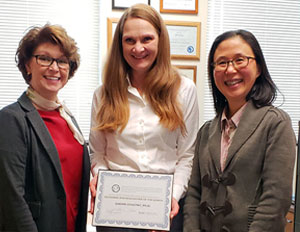 A native of Bismarck, North Dakota, Sherri earned her BS, MBA, and PhD from NDSU. She has been recognized numerous times throughout her career including as the Outstanding Dietetic Educator representing a Dietetic Education Program for the upper Midwest; by her college for the past four school years as someone who has made a difference to students; and she’s earned the James Lebedeff Endowed Professorship Development Award. She considers her most significant research contributions to date are increases in the analysis of macronutrients in foods and increased awareness among the scholarly community that accuracy in food intake, while not easy, is critical to the research process.
A native of Bismarck, North Dakota, Sherri earned her BS, MBA, and PhD from NDSU. She has been recognized numerous times throughout her career including as the Outstanding Dietetic Educator representing a Dietetic Education Program for the upper Midwest; by her college for the past four school years as someone who has made a difference to students; and she’s earned the James Lebedeff Endowed Professorship Development Award. She considers her most significant research contributions to date are increases in the analysis of macronutrients in foods and increased awareness among the scholarly community that accuracy in food intake, while not easy, is critical to the research process.
Currently working with a team of eight students that includes both undergraduate and graduate students, Sherri seeks to inspire by being a role model for the attributes that inspire her. She is personally drawn to researchers who deliver results in an understandable manner and who motivate change without being perceived as offensive or pushy. She coaches her students to keep in mind average consumer science-literacy and to task students with contributions that help the team move forward to improve knowledge and awareness of projects among consumers.
Sherri believes that researchers don’t need to be experts at everything and should instead focus on their individual strengths. Much like the variations in the sound of a concert band’s individual instruments, Sherri doesn’t expect everyone to bring the same abilities to a project. Instead, she strives to bring together a team of dissimilar but complementary skillsets and to make sure they’re all playing from the same set of music. Sherri Stastny is our December Researcher of the Month.
November 2018: Marisol Berti, PhD
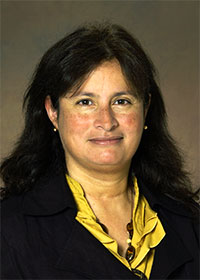 NDSU forage and biomass crop production professor and researcher Marisol Berti is clear about why she’s at the university. “From the students to my partners in extension to my research activities, I just love my job!” This lifelong learner has found success as a forage and cover crops professor. “We are coming up with practical solutions to problems. That’s why our work has grown much in scope in just two years. People connect to what we’re doing because it makes sense and we’re making a difference in their agricultural practices.”
NDSU forage and biomass crop production professor and researcher Marisol Berti is clear about why she’s at the university. “From the students to my partners in extension to my research activities, I just love my job!” This lifelong learner has found success as a forage and cover crops professor. “We are coming up with practical solutions to problems. That’s why our work has grown much in scope in just two years. People connect to what we’re doing because it makes sense and we’re making a difference in their agricultural practices.”
Along with the strong collaboration of other researchers, Berti is a practical scientist who has built an eloquent solution to the problem of protecting agriculture land from erosion. Her research team and other researchers (including extension specialists) have utilized more efficient planting strategies and figured out how to incorporate cover crops between the rows of regular crops. Employing a modified high clearance interseeder drill from Fargo’s Amity Technology, their research has successfully utilized the unplanted spaces by planting two rows of cover crops in-between crops as high as two feet.
“With the recent dry conditions this spring which have caused soil to blow away, our local farmers really appreciate the value of cover crops to protect against the problem of losing the topsoil,” she commented. “In addition, the recent low commodity prices have driven them to find new ways to reduce costs. Our work helps them accomplish both goals.”
By utilizing cover crops with agricultural value or those already targeted in crop rotation cycles, the process provides added value to the producer. The research team has targeted cereal rye for its winter hardiness and performance as cover crop in corn-soybean systems. Another hardy broadleaf, winter camelina, has also shown promise due to its unique ability among broadleaf cover crops to survive North Dakota winters. Berti points out that winter camelina flowers early in the spring, which makes it also beneficial to pollinators, and it has potential as a high quality oilseed crop. These plants, along with traditional alfalfa intercropped into corn, provide additional products for producers while ensuring there is no exposed ground in a field.
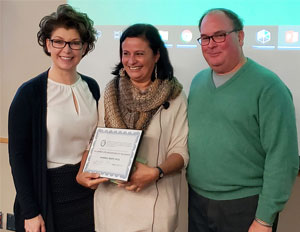
Born in Santiago, Chile, Berti grew up in a family who loved nature and the mountains. She fondly recalls gaining an appreciation for agriculture and the land from her Italian grandfather who grew much of his own food. After earning her BS in agronomy from the Catholic University of Chile, she decided that a large city wasn’t where she wanted to live. When she received a recommendation from one of her professors to intern with a seed company in Breckenridge, Minnesota, she gladly accepted and moved north. It was during this time that she met NDSU professor Albert Schneiter during a field day. Dr. Schneiter saw potential in Berti and recommended that she continue her education at NDSU where she earned her MS and later her Ph.D. in plant sciences. Berti is a lifelong learner who loves to study so much that she would work on another Ph.D. if she had the time. She’s the author or co-author of 60 peer-reviewed publications, 22 conference publications, two book chapters, and more than 150 presentations at conferences or symposiums.
Berti’s love for nature is obvious in her other hobby. When not researching or teaching, she paints nature scenes, flowers, and landscapes. She finds painting is effective in getting her active mind to relax. While her style is realistic, her fine attention to detail is symbolic of her scientific method and discipline. Her pictures are a set of virtual windows in her office to the many places she’s seen and captured. She alludes to this in commenting that while she has lab space at NDSU, she believes her true lab is in the field.
Berti is PI on a four year $3.7 million USDA-NIFA-AFRI grant which includes 12 researchers from four institutions and 11 graduate students (ten from NDSU). Within two years, the project has scaled quickly from NDSU test plots to thousands of acres in farmer’s fields as the adoption of cover crops and interseeding technologies has grown.
While Berti is quick to note that her work is a modification on existing systems and ideas, she’s most proud when she discusses the impact of her work on the people of the area. She gains much from her interactions with other researchers, extension professionals, and agricultural producers. “All that I learn, I pass on to the farmers and they give me back much as well,” she says. “They have great ideas – I love talking with them and learning what they need. In fact, the USDA-NIFA-AFRI project was born from farmers’ ideas in a cover crops workshop three years ago. They are practical and this is a simple solution which is why it works for them so well.”
We recognize Marisol Berti as our RCA Researcher of the month for November, 2018.
October 2018: Brad Benton, PhD
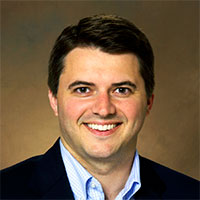 Brad Benton’s office is nestled in the middle of Minard Hall at NDSU. His space is a traditional collegiate setting that features bookshelves packed with a formidable library of tomes, historical architecture prints and classical artwork on the walls, and an antique Sony radio tucked in the corner. Benton himself is a genuinely welcoming person who is interested in finding the commonalities that all people share, which makes
Brad Benton’s office is nestled in the middle of Minard Hall at NDSU. His space is a traditional collegiate setting that features bookshelves packed with a formidable library of tomes, historical architecture prints and classical artwork on the walls, and an antique Sony radio tucked in the corner. Benton himself is a genuinely welcoming person who is interested in finding the commonalities that all people share, which makes
Benton is the October RCA Researcher of the Month. He’s a scholar, writer, and researcher in NDSU’s college of Arts, Humanities, and Social Sciences. He received his Ph.D. in History from UCLA and his MA in Latin American Studies from Tulane University. He’s been recognized with the College of Arts, Humanities, and Social Sciences Outstanding Research Award and has received grants from the National Endowment for the Humanities (NEH) for his translations work and from the Fulbright Commission to conduct research in Spain. him a living example of the type of research work that drives him. He’s a comfortable conversationalist who listens and engages with equal vigor and he makes a mean cup of tea.
He is the author of a recently published book, The Lords of Tetzcoco: The Transformation of Indigenous Rule in Postconquest Central Mexico (New York: Cambridge University Press, 2017) and has collaborated on the editing and translation of other works. The Lords of Tetzcoco, volume 104 in Cambridge’s prestigious and long-running Latin American Studies series, tells the story of native leaders in one Mexican town during the Spanish conquest in the 16th century. Benton sees the book as his most significant research contribution to date.
Benton looks for the human commonalities in his research. He believes that everyone has the same flaws and drives regardless of the time period in which they live and that sometimes the reasons behind these motivations can become fuzzy. In his book, he examines the colonization of the indigenous people in Mexico. His research shows that the old narratives describing native groups as merely powerless victims just isn’t accurate. Instead, many of the native people were more like partners to the Spaniards in creating the new societal models that followed the conquest.
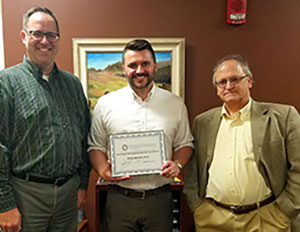
Benton believes historians have a duty to challenge generally-accepted truths like this. “History is not black and white, but gray,” he says. “Humanities scholars are comfortable within these gray areas throughout history and we like to explore the tension that exists in them.” He challenges his students to think critically about commonly held historical narratives, to look beyond the oversimplifications that tend to plague them, and to see the ways in which people across time and place share a common human experience.
For Benton, research has been a critical part of his career development and he believes his research both informs and influences the stories he incorporates in his teaching. In researching The Lords of Tetzcoco, Benton spent time in historical archives located in Mexico (at an UNESCO site that was previously a federal penitentiary) and in Spain (at the Archive of the Indies in Seville). The 500 year old documents he examined were written in both Spanish and the native Nahuatl (Aztec) language. The handwriting, however, was as difficult to understand as the languages. Benton both anticipated and welcomed this challenge as deciphering handwriting is a skill he has nurtured, studied, and taught.
While he notes that working as an historian can be solitary work, Benton also remembers fondly the friendships he made in the archives with the other researchers from across the globe and how he has maintained them after returning home. As a scholar and researcher who values people, Benton appreciates learning about what binds people to each other. Benton puts this belief in action with his students by opening up his network of contacts to them. He see this as a benefit to all involved as it creates an ever-widening group of potential collaborators.
Brad Benton is a historian and scholar who values his network of peers and colleagues and the people who lived the histories of which he is so enamored. He is our October Researcher of the Month.
September 2018: Julia Bowsher, PhD
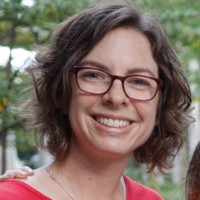 Julia Bowsher absolutely loves insects. That is, except cockroaches. But otherwise, she finds all insects fascinating and she’s been studying them since she was five, when she first decided to become a scientist. And her fascination shows—whether it’s the giant antique poster in her office detailing the molting process of the desert locust or how much she gets energized when she’s talking about her work with the black scavenger fly.
Julia Bowsher absolutely loves insects. That is, except cockroaches. But otherwise, she finds all insects fascinating and she’s been studying them since she was five, when she first decided to become a scientist. And her fascination shows—whether it’s the giant antique poster in her office detailing the molting process of the desert locust or how much she gets energized when she’s talking about her work with the black scavenger fly.
Bowsher is being recognized as the inaugural RCA Researcher of the Month. As an NDSU Associate Professor, she received her PhD in evolution from Duke University and has taught and conducted research in evolutionary and developmental biology at NDSU since 2010. Bowsher recalls always wanting to be a scientist and at Duke, she found an inspirational mentor and kindred spirit in her adviser, Frederik Nijhout. She credits Nijhout with showing her the value of being brave enough to fail and for following the ever-changing path of curiosity that has led both to learn about a variety of insects.
Recently returning from a collaborative research study at the National University of Singapore with world-renowned black scavenger fly expert Rudolf Meier, Bowsher is excited about learning and bringing CRISPR technology to NDSU. A revolutionary technology, CRISPR allows for gene editing and quicker mutations, which speeds up her research.
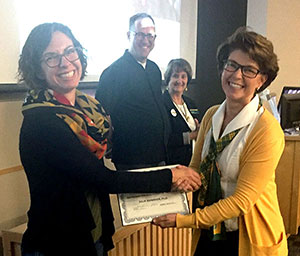
Bowsher has recently been awarded a $2.85 million NSF EPSCoR Track-2 grant, studying Insect Cryobiology and Ecophysiology (ICE) Network: Integrating Genomics, Physiology, and Modeling. The goal of the ICE Network is to understand how bees overcome harsh winter conditions to successfully emerge and reproduce in spring. Bowsher has been studying bees for years and is proud of how the concept of “Save the Bees” has taken off. Along with her NDSU colleagues, Kendra Greenlee and Saeed Salem, the grant includes collaborators from the USDA, New Mexico State University, and the University of Wyoming.
Bowsher’s advice to new researchers is simple: success is all about time management. She’s taught time management philosophies to fellow faculty members and students. Finding time to do everything you need to do comes down to owning your time and that’s something you can develop and nurture. The other benefit to owning time is that it gives researchers the time to write, which is another piece of advice she offers. Bowsher sets aside an hour of each day to do her own writing because, as she puts it, “If you’re not writing, you’re not thinking. Plus, writing for an hour gives you a sense of accomplishment and that’s a great way to start every day.”
In her spare time, Bowsher is a triathlete and trains with her colleagues. Exercising with her peers is a great method to share ideas and converse about research. And most importantly, she says, it takes her mind off the exercise itself.


